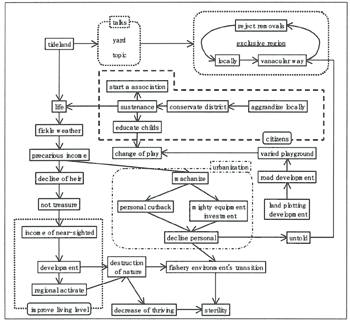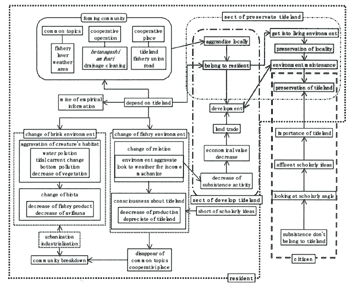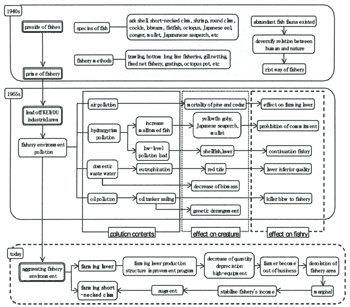|
RESULT
Current Status of Inhabitation
The habitation conditions in the BANZU Tideland are as follows:
1. Many species protected by Chiba Prefecture live and grow there.
2. The number of types and the quantity of species in the BANZU Tideland exceeds the number of species and types in other tidelands in Chiba.
3. Although various types of species still live and breed there today, this trend is declining. In fact, more species types existed in the Showa 40s than in the present day.
From these facts, it seems that BANZU Tideland has more and varied possibilities for developing relationships between people and other inhabitants compared to other tidal shores because it has more numbers and types of species than those in other distinguished tidelands in Chiba such as SANBANZE or YATSU Tideland.
Relationship between the Residents /the Citizens and Nature
Based on the interview surveys, Figures 2 and 3 indicate the way the residents and citizens in BANZU Tideland relate to the nature around the tideland in their daily lives. Figure 2 indicates the ways nature and people surrounding BANZU Tideland relate to one another. Figure 3 shows how BANZU Tideland relates to the surrounding nature and area. These figures were developed based on each inter-relationship after analyzing the behavior and thinking patterns of the residents and the citizens by evaluating these factors according to the reference study and interview survey information. From here, this paper will demonstrate the inter-relationship between the residents/citizens and nature, and the community and nature surrounding the tideland as their center.
| (Enlarge: 57KB) |
 |
Figure 2. The ways nature and people surrounding BANZU Tideland
| (Enlarge: 86KB) |
 |
Figure 3. BANZU Tideland relates to the surrounding nature and area
Relationship between Residents and Nature
In this community, most people have depended on the semi-agricultural and semi-fishing industry for their living since long ago. Also, because many residents have lived there all their lives, they have chosen a life style that is dependent on nature.
"To create a place of recreation/relaxation is the same as making a place of recreation through fishing in the case of Kaneda Community. This is after all, a place where we all weaved bamboo screens on which to dry the seaweed, you may have seen it. Then, we all put the seaweed on the nets. After doing all these things together, the process then went like this: when making a net, only men from the neighborhood got together and weaved all day while drinking cups of tea together. Women likewise worked on something while chatting all day. So, work had become a place of recreation."
In the past, children used to play outside in places such as Obitsu River, BANZU Tideland, in fields and on vacant land. It was simply the gathering of neighborhood children. And when their play involved something to do with nature, they actually ate what they caught or sold it to get some pocket money. From these activities, it is very easy to understand how children in the past could nurture a rich knowledge of nature because their playground and playthings were deeply related to nature. Knowledge gained in such a manner was not the intellectual kind gained from books and school classes, but was that gained from their own experience and routines.
"Also, it is prohibited now, but we had this stuff, (Japanese) mist net. Friends from the elementary school used to play with this a lot. We went to Kisarazu-town to buy the stuff, then took it to the tideland to hunt birds: Japanese white-eye, also amadavat. There was a middle-aged guy in our neighborhood who wanted to buy them. We sold them to get some pocket money ourselves. That was how we played."
As you heard, the life style itself depended on and had affinity with nature; team work for livelihood and playing with neighborhood children created interactions. Also, customs and neighborhood relationships borne from this livelihood (marriage courtship "Koyasu-Koh"(that is an association of wives. It originated from their belief in the "Koyasu god" to whom they pray for easy delivery and fertility, etc.), Shut-in day building a Bonnden and funeral custom still remains in the community. With this in mind, it seems clear that the relationship among residents with similar life styles brings them closer to one another, increasing the opportunities for interaction because of the customs and neighborhood connections, resulting in a deepening of their relationships.
"Now, it has become something of a treat, but "Koyasu-Koh" used to take place during childbirth and involved carrying something resembling a hook to help a mother have an easier delivery. But such occasions have become less, so it seems true that now it's like, "let's get together and just have a cup of tea" type of thing, don't you think? In the past, they seemed to do "Koyasu-Koh" a lot."
"I heard a story from the Edo (Tokugawa) period. A Tokugawa government's ship was sunk. So, to show that it was not their fault, they built a Bonnden (a guardian idol). This is not really an old story. Anyhow, a ship was sunk and they were blamed for it. That kind of thing happened sometimes. I really do not know much about the details."
As is evident, this community has active residential interactions among those sharing a similar life style through livelihood; nevertheless, the fishing industry environment surrounding BANZU Tideland has changed. Based on the reference study and interview survey, an obvious change in the fishing industry environment is shown in Figure 4. According to this figure, the differences are clearly distinguishable among the pre-1960s, the golden age of the fishing industry, the 1960s when the pollution of the fishing field became extremely bad and the present day in which the fishing style has greatly changed. Factory industry began to coexist polluting the fishing fields, resulting in many occurrences of fish deformity or fish with bad odor. Then, the fishing industry was prevented from conducting their businesses in the market. As a result, the residents changed the target of their livelihood from fish to dry seaweed production and shellfish farming selling shellfish such as clams, which were less susceptible to the effects of pollution. Consequently, many residents have been on the verge of giving up on the fishing industry because of the income decrease.
| (Enlarge: 83KB) |
 |
Figure 4. Change of fishing industry environment
|